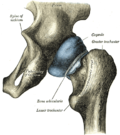Ilium (bone)
Ilium is the uppermost and largest part of the hip bone, and appears in most vertebrates including mammals and birds, but not bony fish. All reptiles have an ilium except snakes, although some snake species have a tiny bone which is considered an ilium.
The ilium of the human is divisible into two parts, the body and the ala; the separation is indicated on the top surface by a curved line, the arcuate line, and on the external surface by the margin of the acetabulum.
Anatomy[edit]
The ilium forms the large, fan-shaped portion of the hip bone. It is located superior to the ischium and pubis, which are the other two parts that make up the hip bone. The ilium is broad and expanded and is responsible for the width of the pelvis.
Body of ilium[edit]
The body of the ilium forms the sacroiliac joint with the sacrum at its auricular surface. The body contains the iliac fossa, which is bounded by the iliac crest. The iliac crest starts from the anterior superior iliac spine and ends in the posterior superior iliac spine.
Ala of ilium[edit]
The ala or "wing" of the ilium has a smooth, concave surface, called the iliac fossa, which gives origin to the iliacus muscle. The iliac fossa is bounded above by the iliac crest, and below by the arcuate line.
Function[edit]
The ilium's main function is to provide support for the body and serves as a point of attachment for several muscles. These include the gluteal muscles, which are responsible for hip movement, and the iliopsoas muscle, which is a major flexor of the hip joint.
Clinical significance[edit]
Conditions that can affect the ilium include sacroiliitis, which is inflammation of the sacroiliac joint, and iliac crest syndrome, which is characterized by pain in the iliac crest.
See also[edit]
References[edit]
<references group="" responsive="1"></references>
Ilium (bone)[edit]
-
Diagram of the pelvis
-
Gray's Anatomy illustration of the ilium
Ad. Transform your life with W8MD's Budget GLP-1 injections from $75


W8MD offers a medical weight loss program to lose weight in Philadelphia. Our physician-supervised medical weight loss provides:
- Weight loss injections in NYC (generic and brand names):
- Zepbound / Mounjaro, Wegovy / Ozempic, Saxenda
- Most insurances accepted or discounted self-pay rates. We will obtain insurance prior authorizations if needed.
- Generic GLP1 weight loss injections from $75 for the starting dose.
- Also offer prescription weight loss medications including Phentermine, Qsymia, Diethylpropion, Contrave etc.
NYC weight loss doctor appointmentsNYC weight loss doctor appointments
Start your NYC weight loss journey today at our NYC medical weight loss and Philadelphia medical weight loss clinics.
- Call 718-946-5500 to lose weight in NYC or for medical weight loss in Philadelphia 215-676-2334.
- Tags:NYC medical weight loss, Philadelphia lose weight Zepbound NYC, Budget GLP1 weight loss injections, Wegovy Philadelphia, Wegovy NYC, Philadelphia medical weight loss, Brookly weight loss and Wegovy NYC
|
WikiMD's Wellness Encyclopedia |
| Let Food Be Thy Medicine Medicine Thy Food - Hippocrates |
Medical Disclaimer: WikiMD is not a substitute for professional medical advice. The information on WikiMD is provided as an information resource only, may be incorrect, outdated or misleading, and is not to be used or relied on for any diagnostic or treatment purposes. Please consult your health care provider before making any healthcare decisions or for guidance about a specific medical condition. WikiMD expressly disclaims responsibility, and shall have no liability, for any damages, loss, injury, or liability whatsoever suffered as a result of your reliance on the information contained in this site. By visiting this site you agree to the foregoing terms and conditions, which may from time to time be changed or supplemented by WikiMD. If you do not agree to the foregoing terms and conditions, you should not enter or use this site. See full disclaimer.
Credits:Most images are courtesy of Wikimedia commons, and templates, categories Wikipedia, licensed under CC BY SA or similar.
Translate this page: - East Asian
中文,
日本,
한국어,
South Asian
हिन्दी,
தமிழ்,
తెలుగు,
Urdu,
ಕನ್ನಡ,
Southeast Asian
Indonesian,
Vietnamese,
Thai,
မြန်မာဘာသာ,
বাংলা
European
español,
Deutsch,
français,
Greek,
português do Brasil,
polski,
română,
русский,
Nederlands,
norsk,
svenska,
suomi,
Italian
Middle Eastern & African
عربى,
Turkish,
Persian,
Hebrew,
Afrikaans,
isiZulu,
Kiswahili,
Other
Bulgarian,
Hungarian,
Czech,
Swedish,
മലയാളം,
मराठी,
ਪੰਜਾਬੀ,
ગુજરાતી,
Portuguese,
Ukrainian


